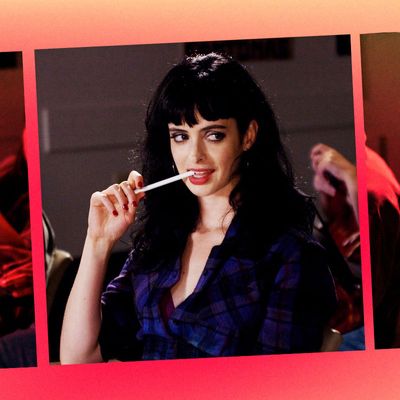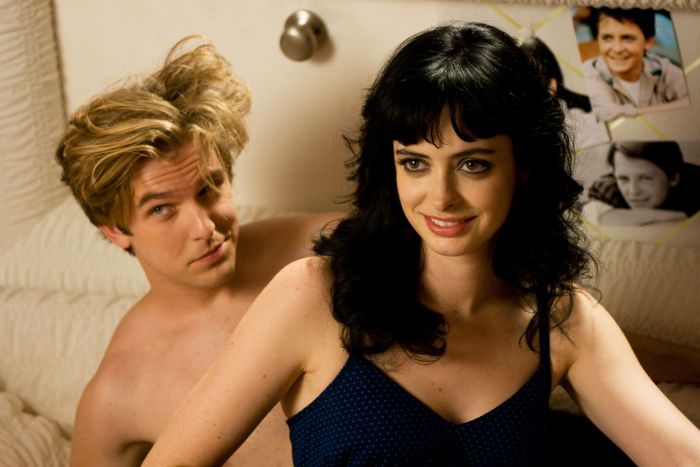
Warmhearted and sweet are not adjectives typically used to describe vampire movies. But both apply to Amy Heckerling’s Vamps, the 2012 comedy set and partially shot in New York about a pair of vampy besties (Krysten Ritter and Alicia Silverstone) who, thanks to their immortality, are perpetually stuck in their 20s.
In the hands of Heckerling, who both wrote and directed, the film is a comedy, a commentary on aging, and a fun horror rom-com draped in goth fashion and smeared with black eyeliner. The movie wasn’t a hit when it came out, which is surprising given both its Vampire Clueless vibes and the quality of its cast. In addition to Ritter and Silverstone, the ensemble includes Sigourney Weaver, Dan Stevens prior to his Downton Abbey departure, Wallace Shawn, Malcolm McDowell, Richard Lewis, and Justin Kirk.
But Ritter remembers that it was a fun film to shoot and one that allowed her to work with one of her filmmaking heroes in Heckerling. While on location in Austin, Texas, shooting the forthcoming HBO Max limited series Love and Death, Ritter hopped on the phone to talk about her Vamps memories, functioning on vampire hours while shooting a vampire movie, and the kindness of Sigourney Weaver. Oh, yeah, we also talked about Kiefer Sutherland’s hotness in The Lost Boys.
Let’s start at the beginning: how did you get the role in the movie? Did you have to audition?
I actually didn’t have to audition. It was one of those scripts that was around for a long time. This is like 10 years ago or more. I had had a general [meeting] with Amy Heckerling, who I love and adore and worshipped growing up. I watched Clueless more times than you can count. And then one day it just came into our orbit and they ended up hiring me, and then starting the auditioning process for what ends up being Alicia Silverstone’s role. I started doing chemistry reads with other actresses, and then they gave it to Alicia and we went on location in Detroit.
What you don’t think about as a young actress is when you’re doing a vampire movie, you’re going to be filming all night. All night, every night. So in the hotel — this is a trick that I learned that I still employ now that I’m a mom — I have to get tinfoil to black out my hotel room so I could sleep during the day, like a real-life vampire.
Did it help you get into character that you literally were living a vampire lifestyle?
That schedule is so hard, I don’t think it helps with anything ever. But you do start to get a little used to it. We would film, like, 10 to 10 or seven to seven everyday, p.m. to a.m. But I literally have the tinfoil on my windows in my apartment in Austin right now. Same thing. Vampire blacked out.
As somebody who watched Clueless over and over again, what was it like to actually meet Alicia and work with her?
It was amazing, she was so cool. Mona May also did the costumes. In Vamps, I wore this vintage dress. It’s black, ’80s kind of shoulders with these metal pieces — that was actually Amy Heckerling’s.
Oh, really?
Yeah, because she’s super gothed-out. She had it from when she was younger, and kept it for her daughter, and I ended up wearing it in the movie, which was super-cool.
Working with Alicia was heaven. We hit it off immediately. She’s vegan and wrote this amazing book, The Kind Diet, and offered to feed me and a couple other people as well. So I was like, “Yes, whatever she’s eating, I’m gonna eat that too.” That was kind of the only time in my life that I really was able to get really hardcore about trying out a vegan diet. She ended up actually getting pregnant [during filming] and getting kind of sick from her food, so that only lasted maybe the first half of the movie. But she was so generous, and we had so much fun together.
I mean, the cast of this movie, many of whom have worked with Amy before, features a lot of great people. Was there anyone else in the cast that made you especially say, “Wow, I can’t believe I’m working with this person”?
Obviously, Wally Shawn being there. Dan Stevens totally blew up after that. Sigourney Weaver, who I ended up working with again on Defenders.Getting to work with her was awesome. It was a point in my career where it felt like a very big deal to get a lead in a movie like that.
You were talking about that dress earlier — I imagine working with the costumes on this movie was pretty fun. Like you said, it was a gothy kind of aesthetic.
Oh, and the fangs, the adorable little fangs that I got to wear, which I thought I was going to get to keep. That would have been nice. They do a mold of your mouth to make your cute little fangs, but they kept them for some reason. Like, “Why? Who else is gonna be able to wear those?”
Were you into horror or vampires when you were younger?
I think coming of age, I loved The Lost Boys. I, like, really loved The Lost Boys. I really loved The Craft, and really loved Scream. Growing up, that was exactly my bubble. I went through a phase where I tried to get into witchcraft, like we all did. That was my genre. I like stuff that’s heightened and elevated, but I also love how seriously the genre takes coming-of-age issues.
I was also very into The Lost Boys, so I can relate.
Kiefer Sutherland in that is just, like — I mean, Jason Patric is not too shabby either, but Kiefer in that movie is just so cool, head to toe. And the soundtrack: so good.
Kiefer Sutherland’s haircut is just terrible, and yet he’s still frightening and hot and all that stuff at the same time.
And he barely says anything in the movie. And he’s so pale. “They’re only noodles, Michael.” I just loved all of it.
What you were just saying about how horror takes on these real issues, but in this heightened way — I feel like Vamps did that, too. Amy is really talks about aging and that whole process from a woman’s perspective.
That is something that sticks out the most to me about making it and what Amy was trying to say. I don’t remember much of it, but I remember there being a line: “Staying young is getting old.” It was Alicia’s line and that day Amy was just like, “This line is really important. This is what it’s all about.” I think Amy was someone who felt in her life and her career frustrated by the changes and trying to stay relevant and keep up. It was what the movie was exactly about and it really came from Amy’s heart. I appreciate that.
That theme comes through in a lot of the film. You have a line at one point where you say, “Remember when we said we’d keep up with the times even though it’s not as good as the ’80s?” That’s one of my favorite lines in the movie.
Totally, totally.
Then there’s the climactic scene near the end of the movie where you’re trying to slay Sigourney Weaver. What do you remember about shooting that?
When we were filming that, my grandfather died and I still had to go to work and do that. It was very hard to — you know, little girls and their grandpas. I remember Sigourney Weaver being very generous with me and very loving. She heard what happened. You don’t get to take a day off when you’re an actress or in the business. You still have to show up, so it was hard. She knew and just kind of snuck up on me and gave me a lot of hugs and love. So that’s something that I remember from that experience. Probably not the answer that you’re looking for, but …
That’s nice, though. There is also the scene at the end that you shot in Times Square where Alicia’s character finally starts to age. How did being in that location work?
It was hard. We shut down Times Square. We were racing against the sun coming up, of course. We blocked up as much as we could. I remember feeling a big emotional impact in that scene. Every once in a while, I think something hits you a little harder than you think it will, and I really felt that, watching [Silverstone’s] character kind of disappear, disintegrate. I think a friend of mine was in New York, walking by, who I hadn’t seen in a while. I was like, “Hey. Doing this vampire movie.” That’s the exciting thing about New York, right? Like anything could happen.
You recently directed four episodes of The Girl in the Woods, which just came out on Peacock. Is there anything that you took away from working with Amy that you apply now when you’re directing?
Yeah, I mean, everywhere. I’ve been so fortunate in my career that I have mostly worked with female directors — women all over the place, writers and directors. And she was someone who I looked up to so much. She had such a great eye and was such a great collaborator. She made actors feel a part of the process. That’s something that I always appreciate when I’m an actor. You want to feel a part of it. I’ve always felt like I was able to give the performance I wanted to give when I’ve been encouraged and supported. Amy was someone like that, and that’s something that I try to bring to set when I’m directing as well.
When Vamps came out, it didn’t get a ton of attention. People are still discovering it, which is a nice thing, but it’s a shame that people didn’t pay enough attention when it was first released.
You never know what’s going to happen with anything, ever. I feel like I’ve had a lot of projects like that in my career, a lot of things that really worked and were fabulous and other things that just don’t line up. I’ve been doing this for over 20 years, and you just kind of do the work and look at it in bite-size pieces and keep your head down.
You have to catch lightning in a bottle from script development, to casting, filming, distribution, release date — all of these things have to really line up. But it is a movie that has a little bit of a cult following, and people still do find it randomly. It’s one of those little, weird movies that is actually pretty cute and fun.
This interview has been edited and condensed.
More from Vampire Week
- Vampire Veek Will Never Die
- Against Vampires
- The Greatest Place to Be a Vampire Was New York in the ’90s



